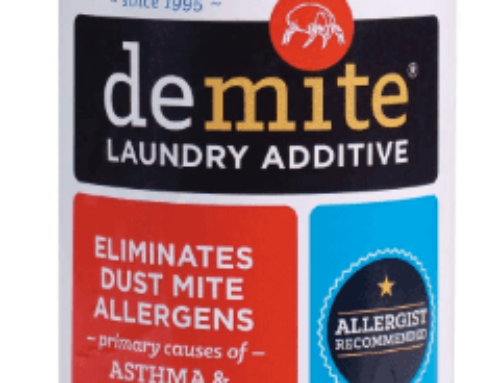Table of Contents
The next time you have a sneezing bout at home, it may not be the chilling draught that creeps through the window. There is a chance that it was caused by millions of dust mites residing in your home. Dust mites grow in the majority of homes around the world and they can be more than a minor irritant.
Factors That Encourage Dust Mites Growth
You’ll probably never notice the numerous dust mites that crawl over your skin. That’s because they are microscopic in size, and escaped normal human vision. Each dust mite measures 0.3 millimeters on average, which is smaller than the full-stop at the end of this sentence.
The claims that there are millions of dust mites in your home is not an understatement. These tiny pests are known to grow exponentially. A single female dust mite can lay between 40 to 80 eggs. It takes an average of 30 days for the hatchling to grow into adult dust mites and they live for a further 90 days.
The rapid growth of dust mites is aided by these factors, temperature, humidity, and food. Dust mites thrive when the temperature varies between 20 – 25 Degree Celcius and relative humidity of 80%-90%. That’s the ambient temperature of many homes around the world.
Besides environmental parameters, dust mites require foods to fuel their growth. They snack on dead skin cells shed by humans to derive the required nutrient. In other words, you and your family members are indirectly the food source for dust mites.
Where Do Dust Mites Live
Your home may look spotlessly clean. But that doesn’t mean it is free from colonies of dust mites. As dust mites are not visible, you’ll be oblivious to their presence until you start developing allergic symptoms. That’s when you embark on a mission to get rid of dust mites from your home.
To defeat the unseen enemy, you’ll want to know where they live. It isn’t too difficult to figure out the hiding space of dust mites. Logically, they grow in places that are warm, humid and have an endless supply of food (aka dead skin cells).
Here are the main suspect places where you can find dust mites in numbers
1. Bedings

If you have issues with dust mites, you should start hunting them in your bedroom, particularly on the bed. As you spend an average of hours sleeping on the mattress, you’ll be shedding enough skin cells to feed millions of dust mites.
Unless you have a hypoallergenic mattress, the dust mites are usually entrenched within the fabric of the mattress. Besides that, you can also expect dust mites making a home in pillows, blankets, and comforters.
If you start getting teary eyes and sneezing each time you make the bed, it is very likely that you just sent loads of dust mites and their excretion into the air. The excretions or fecal pellets are what trigger allergic reactions.
2. Cushion
You may enjoy spending hours lazing on the cushion and catching your favorite TV show. But what you may not realize is the fact that you’re shedding off skin cells that fuel dust mites growth in the cushion. If you’re killing off dust mites in your home, the cushion should be the next spot after you’re done with the beddings.
3. Carpets
Having carpets at home does indeed increase its aesthetic value. Besides, it’s more comfortable to step on the soft texture of the carpet than cold-hard floor tiles. However, having a few hundred square feet of carpets means an extremely large open space for dust mites to grow.
It is common knowledge that carpet makes an excellent trap for dirt and dust. It takes an awful lot of vacuuming to ensure the carpets are clean and inhabitable for dust mites. If you’re extremely sensitive to dust mites, it’s best to remove carpets in your home.
Alternatively, arm yourself with a steam cleaner and kill dust mites hiding in the carpet with high-temperature vapor.
4. Upholstery Furniture
Some people prefer fabric, padding or webbings in their furniture. In other words, nothing but upholstery furniture is installed in their home. While that may convey a sense of modern elegance, upholstery furniture is also great hiding spots for dust mites as the fabrics can trap dust easily.
5. Stuffed Toys

Stuffed toys are adorable for both adults and children. And some people may have an army of them at home. They could be a joy to look at, or even make a comfortable bedtime companion. But in doing so, you may inhale in thousands of dust mites that may have set up a resident in the stuffed toy.
Common sense says that you should get rid of stuffed toys if you have dust mites allergy. But that’s easier said than done. Instead, you could freeze the stuff toys to kill off the dust mites, as they couldn’t survive at extreme temperatures. Alternatively, you could spray non-toxic dust mites repellant on the stuffed toys to reduce the dust mites population.
6. Curtains
In order to get uninterrupted sleep, you’ll want to draw the curtain close and block the early sun from shining through the room. While blocking off the lights, the curtains also trapped dust particles that are in the air. There’s a chance that dust mites are having a field day in the curtains and you’ll want to get them cleaned regularly.
7. Dark and Dusty Corners
There are bound to be spaces that are dark and dusty in most homes. Often, they are at the corners of the house that are only cleaned once or twice throughout the years. If you suspect that dust mites are breeding rampantly in hour home, you’ll want to check out these corners and ensure that they are free from dust.
Final Thoughts
It will be far-fetched to claim that you can get rid of every single dust mite from your home. But knowing where they live allows you to keep the population under control. With a reduced number, they produce lesser fecal pellets and hopefully, you will stop suffering from allergic symptoms.
Do you know of more places where dust mites may be hiding in? Share your thoughts in the comment below.
Related:
- Dust vs Dust Mites, Understanding What Matters
- How To Know If You Have Dust Mites At Home
- 12 Natural Home Remedies For Dust Mites That Works
- Dust Mite Allergy Symptoms – Look Out For These Signs
- How To Kill Dust Mites In Your Mattress




HI
I agree with you that a home must look like spotlessly clean but it does not guarantee to be free from dust mites. The post is very informative. After reading this post I am more worried and I would like to know how to get rid of dust mites. I have bookmarked your website for my next visit tomorrow. i will like to spend time on your other post for gaining more knowledge.
Regards
Arun
Hi Arun,
I’m glad it helps. I was initially puzzled for months what triggered all those allergies. It can be worrying if you have children who are sensitive to dust mites.
Cheers,
Kenny